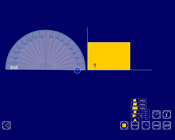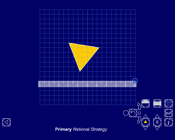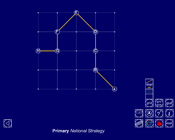Consolidation and practice
These resources are to support children in guided or independent work. Roll over the highlighted resources for a description.
Calculating angles

This interactive teaching program (ITP) is an ICT-based tool to support the exploration of angles. Calculating angles ITP allows the child or teacher to represent single or multiple shapes rotated around a central point in one, two or four quadrants. The size of angles can be estimated or calculated and confirmed using the on-screen protractor or reveal function.
Polygon

This interactive teaching program (ITP) is an ICT-based tool to support the exploration of shape, space and measure. Polygon ITP allows the child or teacher to represent regular polygons with three to ten sides. The ITP can then be used to explore the properties of regular and irregular shapes by dragging vertices and creating additional vertices. The ITP includes an on-screen protractor and ruler.
Fixing points

This interactive teaching program (ITP) is an ICT-based tool to support the exploration of shape and space. Fixing points ITP allows the child or teacher to create one or more shapes by connecting a number of vertices on a grid. Angles can be estimated and measured, and the effect of moving different vertices can be explored.
Opportunities to use and apply
Possible contexts include:
- orienteering in PE;
- work on rotational symmetry;
- reconstructing works of artists who used angle, e.g. Kandinsky;
- creating shapes and repeating patterns, using ICT software;
- drawing and constructing 3-D shapes in design and technology.
Confirming learning
Ask probing questions such as:
- What important tips would you give to someone about using a protractor to measure angles? What mistakes might they make?
- Describe what you would do to estimate the size of an angle. How might annotation help?
- Without measuring, can you draw an angle of approximately 85°? What helped you?
- Kieran measures an obtuse angle and says that it is 182°. Can he be correct? Explain why.

 Understanding shape
Understanding shape


